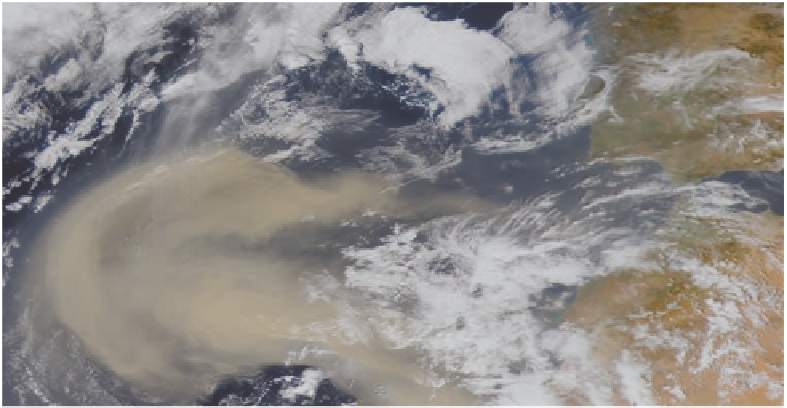Environmental Engineering Reference
In-Depth Information
5
Climate
Control
Forest
Renewal
Water
Grassland
Renewal
Climate and Biodiversity
Land
Biodiversity
CASE STUDY
Blowing in the Wind:
A Story of Connections
rently studying possible links between contaminated
African dust and a sharp rise in rates of asthma in the
Caribbean since 1973.
Particles of iron-rich dust from Africa that enhance
the productivity of algae have been linked to out-
breaks of toxic algal blooms—referred to as
red tides
—
in Florida's coastal waters. People who eat shellfish
contaminated by a toxin produced in red tides can be-
come paralyzed or even die. Europe and the Middle
East also receive contaminated African dust.
Pollution and dust from rapidly industrializing
China and central Asia blow across the Pacific Ocean
and degrade air quality over parts of the western
United States. In 2001, climate scientists reported that
a huge dust storm of soil particles blown from north-
ern China had blanketed areas from Canada to Ari-
zona with a layer of dust. Asian pollution contributes
as much as 10% of West Coast smog—a threat that is
expected to increase.
There is also
mixed news.
Particles from volcanic
eruptions ride the winds, circle the globe, and change
the earth's climate for a while. Emissions from the
1991 eruption of Mount Pinatubo in the Philippines
cooled the earth slightly for 3 years, temporarily
masking signs of global warming. Like the blowing
desert dust, volcanic ash adds valuable trace minerals
to the soil where it settles.
The familiar lesson:
There is no away
because
every-
thing is connected.
Wind acts as part of the planet's
circulatory system for heat, moisture, plant nutrients,
and long-lived pollutants. Movement of soil particles
from one place to another by wind
and water is a natural phenomenon.
When we disturb the soil and leave
it unprotected, we accelerate this
process.
Wind also acts as an important fac-
tor in climate through its influence on
global air circulation patterns. Climate,
in turn, is crucial for determining what
kinds of plant and animal life are found
in the major biomes of the biosphere, as
discussed in this chapter.
Wind,
a vital part of the planet's circulatory system,
connects most life on the earth. Without wind, the
tropics would be unbearably hot and most of the rest
of the planet would freeze.
Winds also transport nutrients from one place to
another. Dust rich in phosphates and iron blows
across the Atlantic from the Sahara Desert in Africa
(Figure 5-1). This movement helps build up agricul-
tural soils in the Bahamas and supplies nutrients for
plants in the rain forest's upper canopy in Brazil. Iron-
rich dust blowing from China's Gobi Desert falls into
the Pacific Ocean between Hawaii and Alaska. This
input of iron stimulates the growth of phytoplankton,
the minute producers that support ocean food webs.
This is the
good news.
Now for the
bad news:
Wind also transports harm-
ful viruses, bacteria, fungi, and particles of long-lived
pesticides and toxic metals. Particles of reddish-brown
soil and pesticides banned in the United States are
blown from Africa's deserts and eroding farmlands
into the sky over Florida. This makes it difficult for the
state to meet federal air pollution standards during
summer months.
More
bad news.
Some types of fungi in this dust
may play a role in degrading or killing coral reefs in
the Florida Keys and the Caribbean. Scientists are cur-
Figure 5-1
Some of the dust shown here blowing
from Africa's Sahara Desert can end up as soil nu-
trients in Amazonian rain forests and toxic air pol-
lutants in Florida and the Caribbean.





